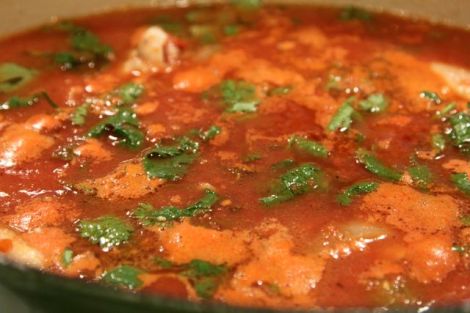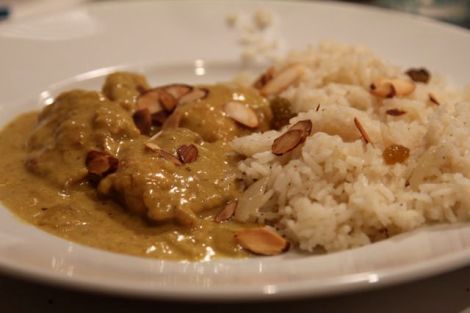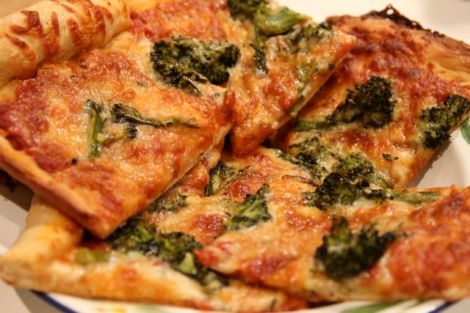Tag Archives: Paying Attention
April 9, 2012 Week 13: Monday Night
 Meal Plan day; I delegated to the children. They came up with an all-mexican plan and I obliged because I am a firm believer that when you delegate you must also abdicate some fair measure of control or you’re not really delegating at all. So that explains why tonight’s Tortilla Soup will be followed later in the week by Chili Pizza (their idea), Chilaquiles and Burritos.
Meal Plan day; I delegated to the children. They came up with an all-mexican plan and I obliged because I am a firm believer that when you delegate you must also abdicate some fair measure of control or you’re not really delegating at all. So that explains why tonight’s Tortilla Soup will be followed later in the week by Chili Pizza (their idea), Chilaquiles and Burritos.
But the real beauty came when I brought them along for the shopping. They decided that they would come up with the “surprise” meal and went off in search of ingredients together. That gave me enough time to invent a salad to go with tonight’s soup: mixed greens, radishes, corn, cherry tomato, grilled red onion and avocado. It was a good combination (and I got the pleasure of using the mandolin successfully on the radishes) but I didn’t like the dressing I made. I’m not sure if it’s because I mixed lime and vinegar or because I shouldn’t have used lime at all. But I quibble; it was deeply satisfying to watch the kids (who didn’t eat any salad when I started the blog) eat a salad which contained that many vegetables.
Every time I begin to question whether or not the blog is a worthwhile endeavor, something always pushes me to continue. Today it was the kids; I can’t help thinking that if I wasn’t paying quite so much attention to how I cook and what I cook, they wouldn’t be quite so interested themselves.
Tags: Blog, Delegating, Kids, Meal Plan, Mexican, Paying Attention, salad, Tortilla Soup
- Leave a comment
- Posted under Meal Plan, Mexican, Salad, Soup
March 21, 2012 Week 11: Tuesday Night
 Making the Tortilla Soup tonight I followed the same technique I did last night: I read the recipe in advance to get the idea of the big picture and then only referred to it when I needed specific instructions. I noticed something interesting: the procedure for making the soup was very similar to the procedure for making the chicken indienne – brown the meat, sauté the vegetables, add the spices, add the liquid & seasonings, simmer. I’ve been cooking these dishes for years without ever noticing this.
Making the Tortilla Soup tonight I followed the same technique I did last night: I read the recipe in advance to get the idea of the big picture and then only referred to it when I needed specific instructions. I noticed something interesting: the procedure for making the soup was very similar to the procedure for making the chicken indienne – brown the meat, sauté the vegetables, add the spices, add the liquid & seasonings, simmer. I’ve been cooking these dishes for years without ever noticing this.
I understand this is not an earth shattering observation. But it does confirm that the process of paying close attention while I cook in order to learn how to cook, is exactly the same thing that I’m doing at school by learning to “close read.” The close read theory is that by making simple observations of a text, a reader can learn to see how writers create prose. Close reading turns any book, essay, short story or poem into a teacher. The blog has become my “close read” of what’s in the pot. My kitchen is now a character in an ongoing dialogue about creativity.
I can already see, for example, how the discovery about the soup/indeinne will be helpful on the days I challenge myself to make up a recipe from ingredients I find at the store. With the technique in mind, I can experiment with vegetables, seasonings and flavorings and create my own dish. Thai coconut curry anyone? I can see it now: chicken, red peppers, green peppers, string beans, eggplant, cocoanut milk. Seasonings? I have no idea; I’ll have to look that up. But I do know how to make it: brown the chicken, sauté the vegetables, add the cocoanut milk, simmer. Nothing Unnatural about that, baby.
Tags: Close Reading, Creativity, Paying Attention, Technique, Tortilla Soup, Unnatural Cook, Writing
- Leave a comment
- Posted under Soup, Technique, Writing
March 18, 2012 Week 10: Sunday Night
 I cooked Chicken Indienne using the recipe in a different way than I usually do. Usually, I take plastic sleeve with the recipe out of my recipe notebook, (see: Meal Plan 101) prop it up on the toaster and follow it, line by line, while I’m cooking.
I cooked Chicken Indienne using the recipe in a different way than I usually do. Usually, I take plastic sleeve with the recipe out of my recipe notebook, (see: Meal Plan 101) prop it up on the toaster and follow it, line by line, while I’m cooking.
This time, I read the recipe before I cooked it and closed the notebook. My intention was to learn how to make it without having to refer to the recipe. It’s a recipe of my mother-in-law’s and I really like certain things about it. For instance, she gives nice proportions for flour, salt & pepper when dredging and browning the chicken. Reading it to memorize it made me read the recipe differently. It allowed me to make a mental note of the order in which she does the obvious stuff (brown chicken, saute onions, add spices, chicken stock & cream), and to focus on memorizing the few measurements I wanted to get right: salt, pepper, curry, candied ginger. I’m pretty sure I could make the whole recipe next time without looking.
By all accounts this was my best batch ever of Chicken Indienne. I don’t think it was a coincidence. I think I have finally learned to pay attention while cooking in a way that takes advantage of all my senses and does not rely solely on sight: ie, my ability to see a recipe.
Now the pilaf recipe, on the other hand, came out of the notebook while I was cooking. This is a Cooks Illustrated Rice Pilaf recipe that is so delicious and so absolutely reliable that I wasn’t going to do any guessing. However, I think I could memorize it too and I did, at least, perform the multi-step process with more ease than is customary.
Tags: Indienne, memorize, mother-in-law, Paying Attention, Recipe Following, Senses
- 2 comments
- Posted under Chicken, Rice
February 17, 2012 Week 7: Friday Night
 So keeping this blog at the same time as I’m in grad school is proving fruitful. (Note food allusion.)
So keeping this blog at the same time as I’m in grad school is proving fruitful. (Note food allusion.)
I am starting to see that my slavish devotion to recipes is a way of not learning. Learning new things takes time and I have never really been interested in taking the time to learn how to cook. I thought I was getting around the problem by following recipes; I could follow instructions and voila! dinner would appear…
But then I started writing about the process of following recipes and made the unfortunate discovery that it was more relaxing to cook when I didn’t follow recipes. It was upsetting because I still didn’t want to devote the time to learn to cook. Then the lessons of grad school kicked in. It turns out that learning to write is really about learning to pay attention to what’s happening when you read. Reading isn’t something new I have to add to my life, I just need to keep doing the same thing, but differently. And now I think it might be true of cooking: I already do it, if I can pay attention to what’s happening when I cook, I can become a better cook.
The blog is basically a way to pay attention to what goes wrong (and right) and use the information to improve the process. To wit: tonight’s pizza. On Week 2: Sunday Night I lamented my inability to roll out pizza dough. I researched to no avail. Next time we had pizza I made sure to plan it for a night that my husband would be home to roll it out; but I couldn’t keep that up for ever. Plus there was something about knowing I would have to write about the pizza, knowing how boring it would be to write about how I couldn’t roll it out – again – that made me and my husband pay attention to when rolling the dough worked and when it failed. (Unfortunately for him he’s gotten dragged into the thing now) And guess what? He figured out a technique that worked! (Remember, he’s the natural cook in the family.)
1) Don’t oil the pizza when you put it in the bowl to rise – oil the bowl that the dough is rising in. The idea is to touch the dough as little as possible and an oiled bowl allows you to flip it out onto the rolling surface without touching it.
2) Drown your work surface in flour before tipping dough out. Don’t be shy. Don’t be stingy. Don’t be obsessed with not wasting things. Flour the surface with gusto, then tip the dough into the middle.
3) Dust the dough & your hands with flour.
4) Punch the dough down & use your knuckles & fingertips to start pushing dough out into circle. Here’s a video of a lady who does this well.
5) When you’ve gotten as far as you can with your hands, use a floured rolling pin to keep expanding the circle. The rolling pin will take it to about 1/2 the size you need.
6) The next step is tricky and I haven’t mastered yet: Lift dough up on closed fists and allow gravity to do the rest of the work stretching the dough out by turning the dough around your fists in an ever widening circle.
I didn’t get that last step quite right this time but I’ll be sure to pay attention next time my husband does it – and I’ll know what to look for. Even still, tonight was the most successful and least stressful interaction I’ve ever had with a ball of dough!
Tags: Grad School. Natural Cook, Paying Attention, Pizza Dough, Reading, Recipes, Technique, Writing
- 4 comments
- Posted under Pizza, Technique